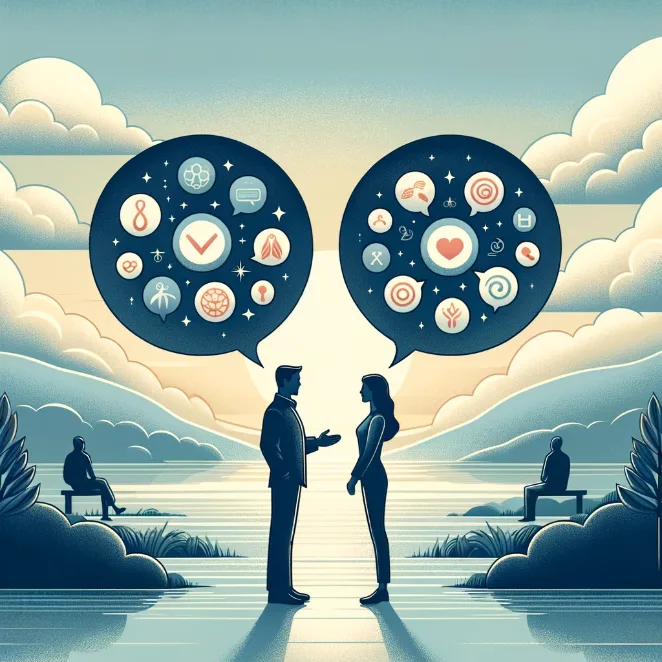
Decoding Compatibility: Myths and Realities
In the quest for fulfilling relationships, the concept of compatibility often emerges as a central theme. However, numerous myths surround this concept, leading to misconceptions about what truly constitutes a compatible partnership. These myths can skew expectations and hinder the formation of healthy relationships. This article aims to dissect some of these myths and contrast them with realities, offering a clearer understanding of what compatibility really means in relationships.
article by Sofia Ferguson
Myth 1: Opposites Attract
The Common Belief: A widespread belief is that opposites attract, leading to the most exciting and sustainable relationships. The Reality: While it's true that opposite traits can initially draw people together, creating a spark of intrigue, long-term compatibility often hinges on shared values and goals. Research in relationship psychology suggests that similarities in personalities, interests, and life views tend to foster deeper, more enduring connections. Opposites may attract in the short term, but similarities provide the common ground necessary for a relationship to flourish over time. Shared values and goals help couples navigate life's challenges together, creating a stronger bond.
Myth 2: Love Conquers All
The Common Belief: Many hold the view that love alone is sufficient to overcome any differences or challenges in a relationship. The Reality: Although love is a crucial component of a successful relationship, it alone cannot resolve all issues. Successful relationships require more than just emotional attachment. They need effective communication, mutual respect, and the ability to navigate conflicts constructively. Relationships thrive when both partners invest in understanding, supporting each other, and working together to resolve differences. Love is the foundation, but it must be coupled with practical skills and mutual effort.

Myth 3: Compatibility Means No Conflict
The Common Belief: Another myth is that if partners are truly compatible, they will rarely, if ever, experience conflict. The Reality: Conflict is a natural and inevitable part of any relationship, regardless of compatibility. What matters is not the absence of conflict but how it is managed. Healthy relationships often involve constructive conflict resolution, where both parties can express themselves, listen, and reach mutual understanding and respect. Learning to navigate disagreements in a healthy way is a sign of a strong, compatible relationship.
Myth 4: Compatibility Is Instant
The Common Belief: The idea of 'love at first sight' often feeds into the myth that compatibility is instantly recognizable. The Reality: True compatibility is typically discovered and developed over time. It involves learning about each other’s quirks, preferences, and values. Lasting relationships are often built on gradual understanding and deepening emotional connection rather than instant chemistry alone. Initial attraction might spark interest, but compatibility is cultivated through shared experiences and emotional growth.
Myth 5: Compatibility Is Unchanging
The Common Belief: Once compatible, always compatible – many believe that compatibility, once established, remains static. The Reality: Compatibility can evolve as individuals grow and change. Maintaining a relationship requires ongoing effort and adaptation. Couples who are open to growth and change, both individually and together, often find their compatibility deepens over time. Adaptability and mutual support are key to sustaining a compatible relationship as life evolves.

Understanding true compatibility is about dispelling myths and embracing the realities of relationship dynamics. It's a blend of mutual attraction, shared values, effective communication, and a willingness to grow together. Recognizing these aspects can lead to more realistic expectations and healthier, more fulfilling relationships. By approaching compatibility with a balanced view, couples can build stronger, more enduring bonds.
Published: 11/23/2023
Modified: 11/23/2023
More predictions
Come back here soon to learn more about yourself and your future


Childhood & Adult Relationship Compatibility
Our childhood experiences, both good and bad, play a pivotal role in shaping our adult relationships. The bonds we form, the lessons we learn, and the wounds we carry from our younger years deeply influence our approach to love, trust, and intimacy in adulthood.


Harmonized Hearts: The Tale of Clara and Leo
In a quaint village where the days flowed gently like the meandering river, Clara and Leo’s lives blossomed. Clara, known for her sparkling eyes and laughter that echoed like a melodious song, was the village’s ray of sunshine. Leo, with his thoughtful eyes and a heart full of dreams, aspired to be the greatest craftsman the village had ever seen. Their paths often crossed, in the bustling marketplace, beneath the ancient oak tree, or during the vibrant village festivals. Each encounter, brief yet significant, wove a thread of curiosity and fondness between them, planting seeds of a bond that was yet to flourish.